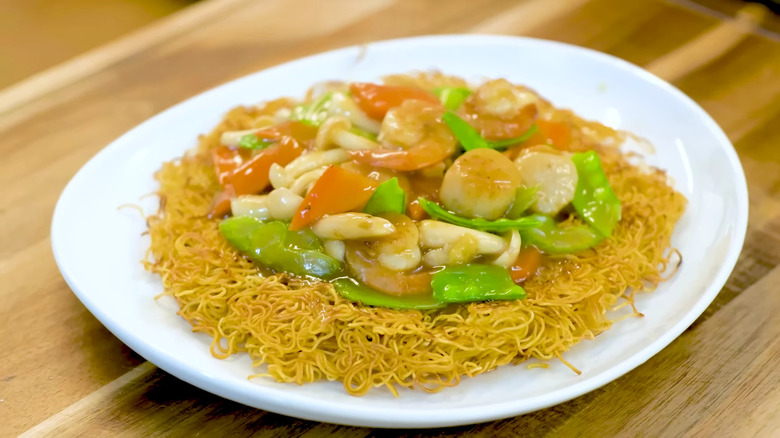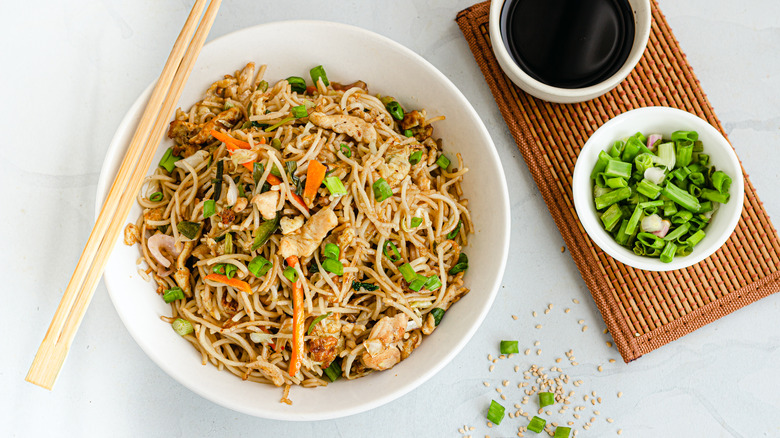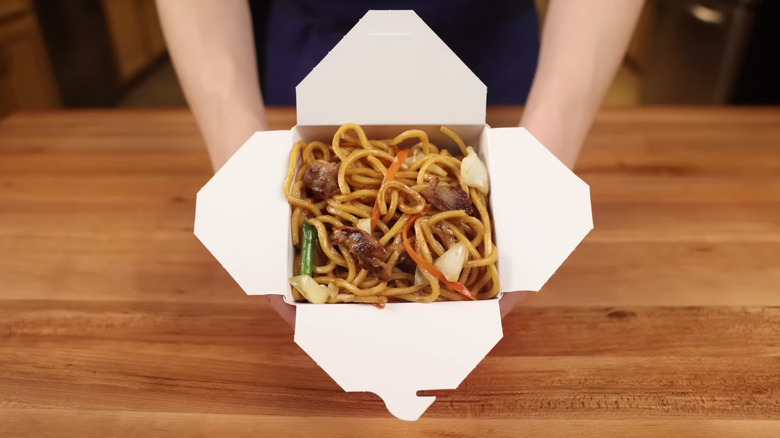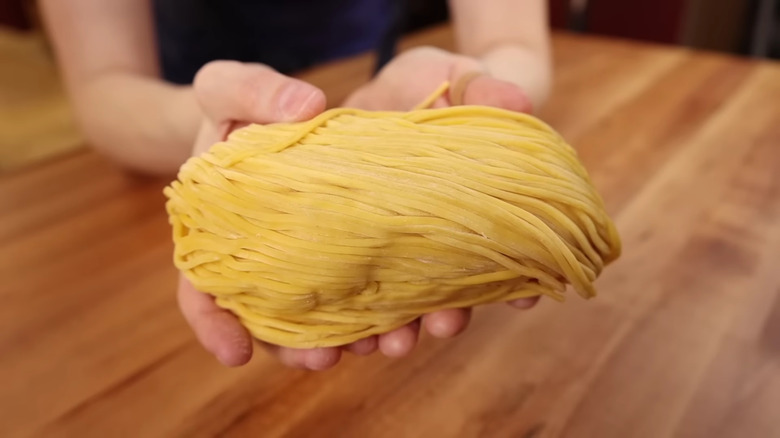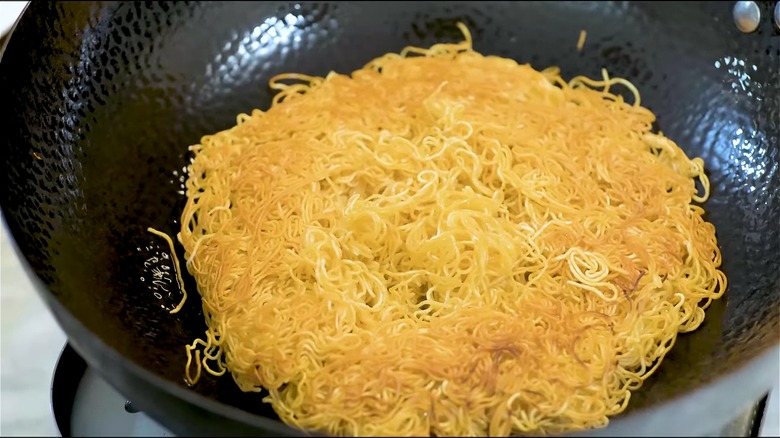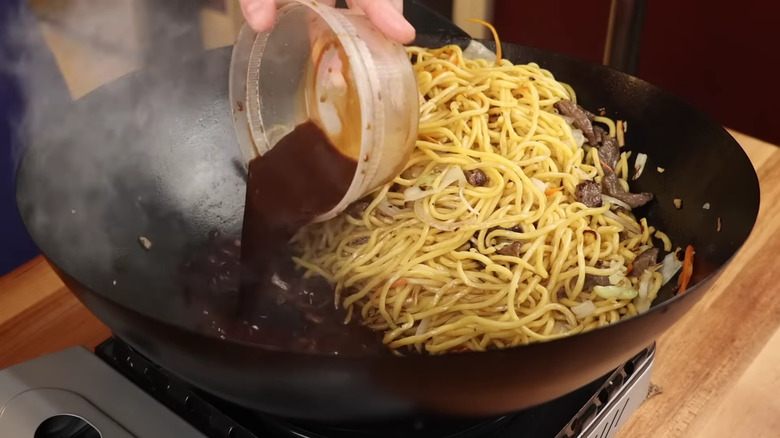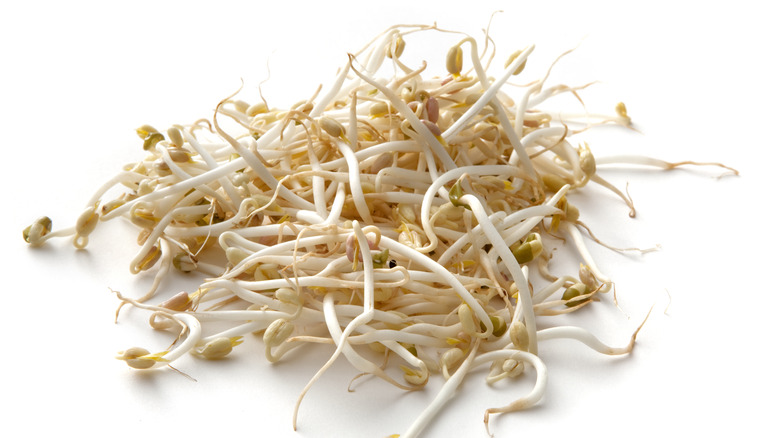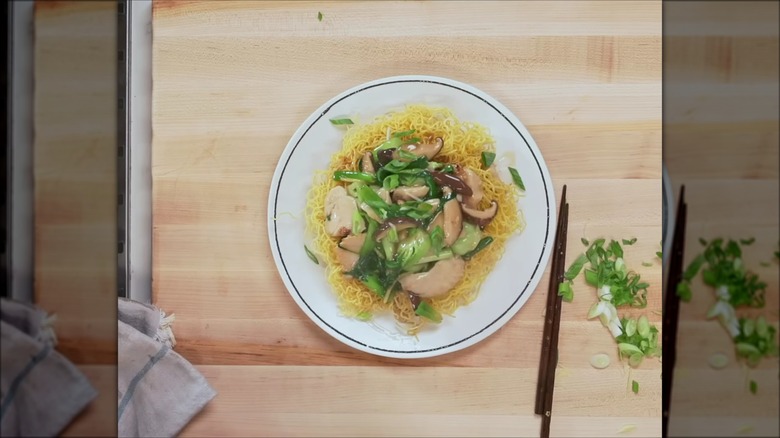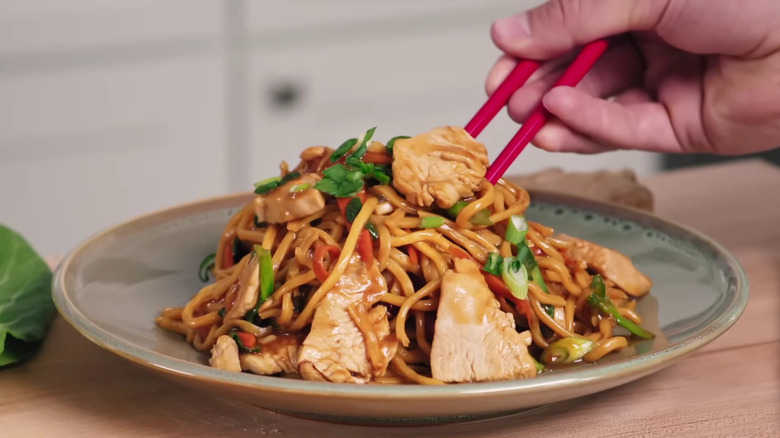What's The Difference Between Chow Mein And Lo Mein?
Dishes like chow mein and lo mein define Chinese American food. But, this does not stop many Americans from getting them confused. Admittedly, the two dishes share several similarities: both involve egg noodles, both include a slick sauce, and both routinely appear on the menu of Chinese-American restaurants. However, chow mein and lo mein are two distinct dishes each with its own ingredients, cooking processes, and textures.
The skills and knowledge needed to make both dishes were introduced to America in the 19th century. During this time, Chinese immigrants moved to the western United States as part of the San Francisco gold rush. As these people set down roots, dishes like chow mein, originally traditional Chinese fare, morphed into something unique due to ingredient availability and local consumer's differing tastes. The upshot of this process has been the development of two distinct Chinese-American dishes that, while similar, have several points of difference.
What is chow mein?
Chow mein is a globally popular dish that originated in southern China. It is thought the term chow mein derives from ch'ao mien, which can be literally translated as 'fried dough' or 'fried noodles.' As is often the case, etymology provides a clue as to the dish's nature; chow mein is a noodle-based dish in which the noodles are traditionally stir-fried. A variety of vegetables and meat or seafood are also present in the dish. Usually, these are finely chopped and stir-fried in a wok. The whole dish is coated with a modest amount of delicate sauce.
While introduced to the United States in the 19th century, chow mein became entrenched during the early 20th century. Over the following decades, chicken became a popular feature in the dish. At the same time, chow mein sauces became increasingly heavy. This heavy style of chow mein fell out of favor in the U.S. during the late 20th century as restaurateurs such as Cecilia Chang revealed to the American public the more nuanced side of many Asian cuisines.
Today, an array of chow mein abounds. These include so-called steamed chow mein in which flash-fried noodles are mixed with vegetables and meat. Another popular version is fried chow mein; a dish that features a disc of fried noodles which serves as a platter for other ingredients.
What is lo mein?
Similarly to chow mein, lo mein is a noodle-based dish that can feature an array of vegetables and animal protein including broccoli, bell peppers, and beef. While all these ingredients play a vital role in the dish, lo mein's definitive ingredient is thick, chewy egg noodles. Aside from retaining a good bite and carrying vast amounts of sauce, these noodles also have a spiritual importance and are often served during celebrations.
While chow mein is translated as 'fried noodles,' lo mein means 'tossed noodles.' This is reflected in the preparation process; instead of being stir-fried, lo mein noodles are boiled before being tossed with the other ingredients. To bind it all together, ample amounts of sauce are used. In the Chinese American version of lo mein, this sauce is typically thick and heavily flavored.
As with chow mein, lo mein is extremely customizable; many ingredients can be added or taken away as desired. This is reflected in the number of lo mein recipes that are around including beef lo mein, vegetarian lo mein, and shrimp lo mein.
Lo mein is made with thicker noodles
One of the main differences between lo mein and chow mein is the type of noodles that are used in each dish. Lo mein is always made with thick, dense egg noodles. These are well-suited to the sauce-rich nature of the finished dish as they can carry a lot more sauce than other, thinner noodles. The lo mein noodles remain soft and chewy throughout the cooking process and during serving. This texture is a hallmark of the dish. As lo mein is so popular, lo mein noodles are readily available. They come in two styles either uncooked or pre-cooked.
In contrast, chow mein is made with thinner egg noodles known as chow mein noodles. These are sometimes called Hong Kong pan-fried noodles and are much easier to fry than lo mein noodles and crisp well during the process. Some versions of chow mein noodles can be fried straight from the packet, others require parboiling.
The dishes are prepared differently
Aside from using distinct noodle types, chow mein and lo mein are differentiated by how each dish is prepared. Chow mein involves parboiling and then frying noodles separate from other ingredients like vegetables, meat, or seafood. This allows cooks to achieve the desired crispiness. How crispy the noodles end up being is a matter of personal preference, however, most good chow mein dishes feature noodles that have at least some crunch.
Once done, the noodles are removed from the pan and the chow mein's other ingredients are fried before everything is combined back together. Some versions of the dish involve creating a disc of fried noodles. In this instance, the vegetables and other ingredients are added as a topping.
However, lo mein is made by cooking the noodles in hot water until they are done. This ensures they develop the soft, chewy texture the dish is known for. Other ingredients, like meat and vegetables, are fried before the noodles are added to the pan along with a rich, thick sauce. Everything is lightly tossed in the pan until incorporated and heated through.
Lo mein sauce is thicker
Interestingly, the sauces for lo mein and chow mein share many common ingredients including soy sauce, oyster sauce, and sesame oil. Shaoxing rice wine is also frequently used in both dishes. However, cornstarch is only ever added to lo mein sauce. This is the ingredient that gives it the desired, thick consistency. If corn starch is not available other thickeners can be used in its place. Thicker consistencies can also be garnered by simmering the lo mein sauce before using.
Classic chow mein is a predominately dry dish. It features a delicate sauce that only lightly coats the crisp, fried noodles. As such, chow mein sauce should always be thin and sparsely used; add too much sauce and you run the risk of turning the crisp chow mein noodles — which should always be the star of the dish — soggy. In contrast, lo mein is all about the sauce. It should be amply applied, richly flavored, and thick, drenching the chewy lo mein noodles and any vegetables and meat.
Chow mein traditionally features dantier vegetables
Chow mein traditionally features lighter vegetables that have a more subtle flavor such as bean sprouts and scallions. On teh other hand, as a heavily sauced dish, lo mein includes robust vegetables that can stand up to the dish's strong flavor and slick texture. As a result, vegetables like broccoli and celery are often included. Snow peas and greens like bok choy are also common features in lo mein. But, as both lo mein and chow mein are viewed as highly customizable dishes, vegetables can be added or substituted at will.
Aside from the type of vegetables that are added, chow mein and lo mein also differ in terms of the amounts of vegetables added. Generally speaking, chow mein features a lower vegetable-to-noodle ratio than lo mein. This ensures that the diner's focus remains on the noodles. The same can be said for meat or seafood, with chow mein typically containing less than lo mein does.
The dishes have different textures
Different noodles and cooking techniques create many discrepancies between chow mein and lo mein. None is as keenly felt as the difference in texture. The fine, stir-fried noodles specific to chow mein result in a largely crisp dish with textural contrast delivered by the softer, small pieces of vegetables and meat. Contrarily, lo mein is an overwhelmingly soft dish. This is thanks to the boiled noodles. In this dish, the fried vegetables are often the crispest part.
Another way the two dishes vary in texture is that chow mein is largely dictated by the person cooking it. By frying the noodles less or more, the finished chow mein can be soft or crisp. The two extremes of the dish — a soft, steamed chow mein and a pancake-like disc of crisp, fried noodles topped with vegetables — demonstrate how much variance there can be. When it comes to making lo mein, cooks have much less control; due to the cooking processes, nearly all lo mein comes out of the kitchen silky and soft.
Which is healthier: chow mein or lo mein?
As with all dishes, both chow mein and lo mein have positive aspects to their nutritional profiles as well as negative. Although the nutritional profiles of both dishes will vary depending on how they are cooked and what is included, both are generally seen as good sources of vitamins and minerals. This is thanks to the abundance of vegetables in both dishes. However, chow mein and lo mein both tend to be high in sodium due to the use of high-salt ingredients like soy sauce.
When the two are compared directly, lo mein is deemed healthier. This is because the noodles are boiled in water as opposed to fried in oil. As a result, a serving of lo mein often contains half the calorie and fat content found in a serving of chow mein.
Due to the versatile and adaptive nature of chow mein and lo mein, both dishes can be made healthier without impacting the dish too much. Some of these simple steps were highlighted to Livestrong by nutritionist Brierley Horton: "Use a healthy cooking oil and opt for leaner proteins like chicken or tofu. Incorporating a large variety of vegetables and limiting the amount of sauce or using a low-sodium sauce can make a significant impact, too."
